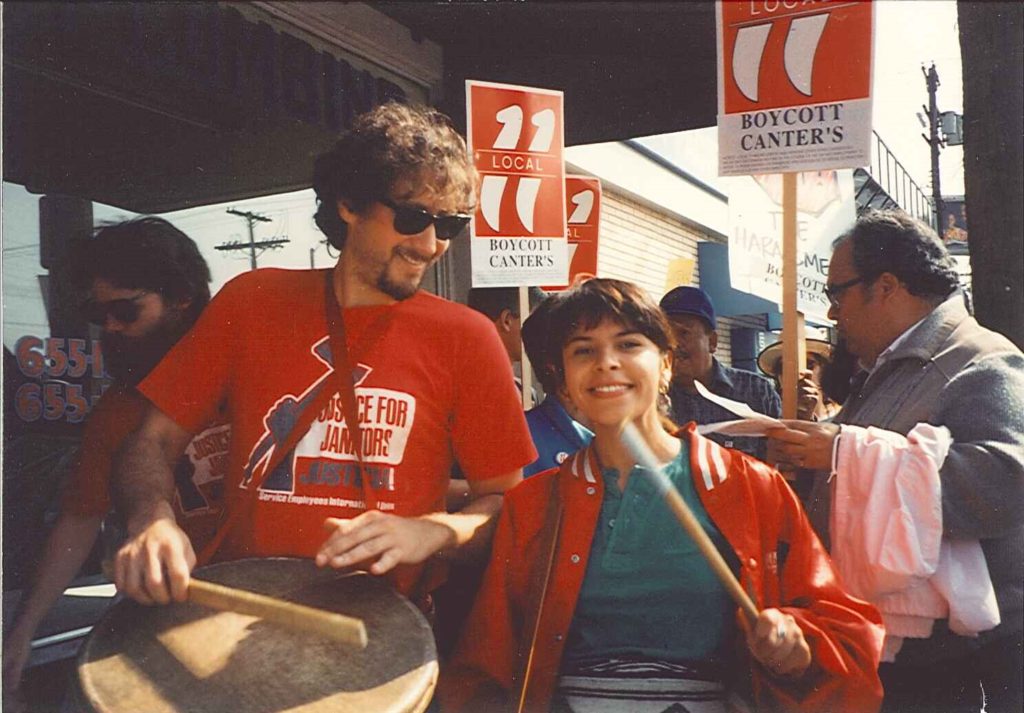Rocio Sáenz recalls the spirit of solidarity among unions in the early 1990s
I come from Mexico City, and I had a union there. Even though, looking back at the unions in Mexico, they were often very corrupt, at the time I thought it was better than nothing. When I came to the U.S., I did a lot of different jobs. I was a domestic worker, I was a salesperson in a store, and stuff like that. But I wanted to be in a unionized workplace, and so I was trying to get a job through a local union. I didn’t know that there was such a thing as being an organizer, but I was making posters and banners for he ILGWU. A few months later, I met someone in Local 11 of HERE and they hired me. Even then, for a few months, I didn’t do organizing. I didn’t even know what it was. But then I got very involved.
I saw a different way to organize [in HERE]. To bring the trust back from the members, and to show that this was a different union. In any organizing drive, you have to show the workers that, yes, you can make a difference. Little victories that you have to deliver, in order to say there is a change. It has to be very, very specific and concrete. And you have to see things as industry-wide. When I was with HERE I remember organizing my first hotel, reorganizing it for the first time in then years. That was in Manhattan Beach, close to the airport. We did it through elections. Well we organized 300 workers, and that was not going to make a big difference for the industry. You have to look at the whole industry, instead of one single work site. You have to do it in a market competitive way. If you’re going to organize, it has to be like all of downtown L.A. has got to go union. It has to be a long-term plan It takes a lot of effort, a lot of persistence, and a lot of resources.

“You’ve got to keep the heat on in different ways, and you’ve got to be very unpredictable
— Rocio Sáenz
Later I came to work for SEIU, in the Justice for Janitors campaign. We still get a lot from HERE, Local 11 especially. We call each other sister unions, and we do a lot of things together. We have marches together, we have a lot of overlap. There is a lot of reciprocity in tactics, in support. In organizing the janitors, we believed, you have to do a lot of things at once. It has to be from the workers’ side, from the company, from the legal, from the community, everything. We drove the employers crazy! You’ve got to keep the heat on in different ways, and you’ve got to be very unpredictable. Because once they know your tactics, they will react.
One of the major things for the campaign was community. We knew that the issues that the workers had at the workplace go beyond those walls of the building, it goes to the community and to the city. So it was important to bring that to the community and get the community into the workplace. Some unions see community involvement just as support. It’s just, “Come to my picket line,” and that’s it. It’s basically numbers or bodies. But for us it was how can we involve the students, and make them feel that this is the future, that they are going to start leading this thing to the future. The immigrant organizations have to see this as a part of their work too. If you want to improve the immigrants’ way of life, you have to get involved in unions, there’s no other way. So the union has do do a lot of stuff outside of the worksite. We started contacting organizations that have been fighting for many different things: housing, immigration, student organizations, and religious organizations, and we started having a response. People are eager to do something militant. Justice for Janitors was a nice way to go for a lot of organizations. The community did delegations, they wrote letters, they tried to call the contractors or the building owners, and they participated in actions.
From Ruth Milkman and Kent Wong, eds., Voices from the Front Lines: Organizing Immigrant Workers in Los Angeles (UCLA Center for Labor Research and Education, 2000): 23-30.
